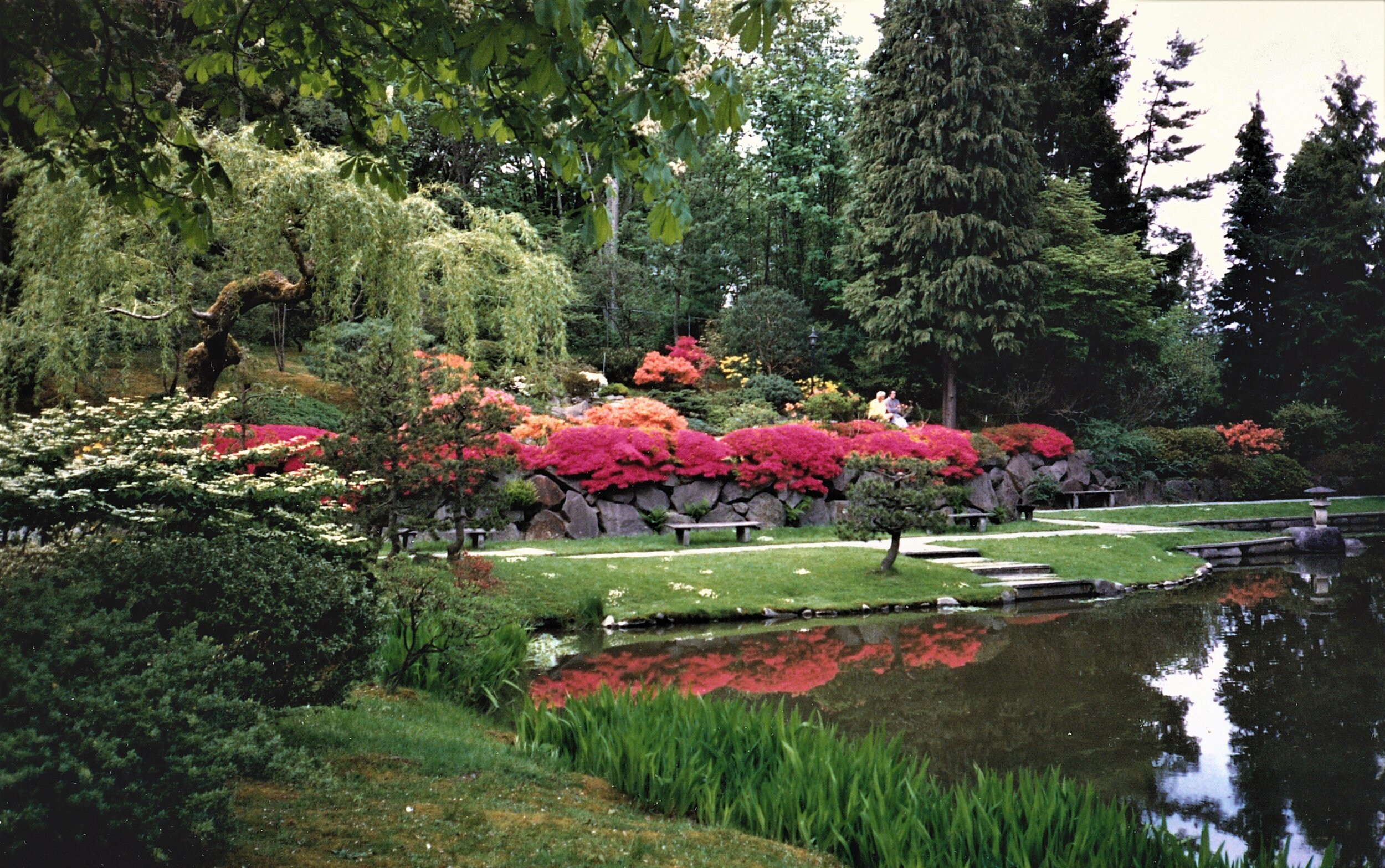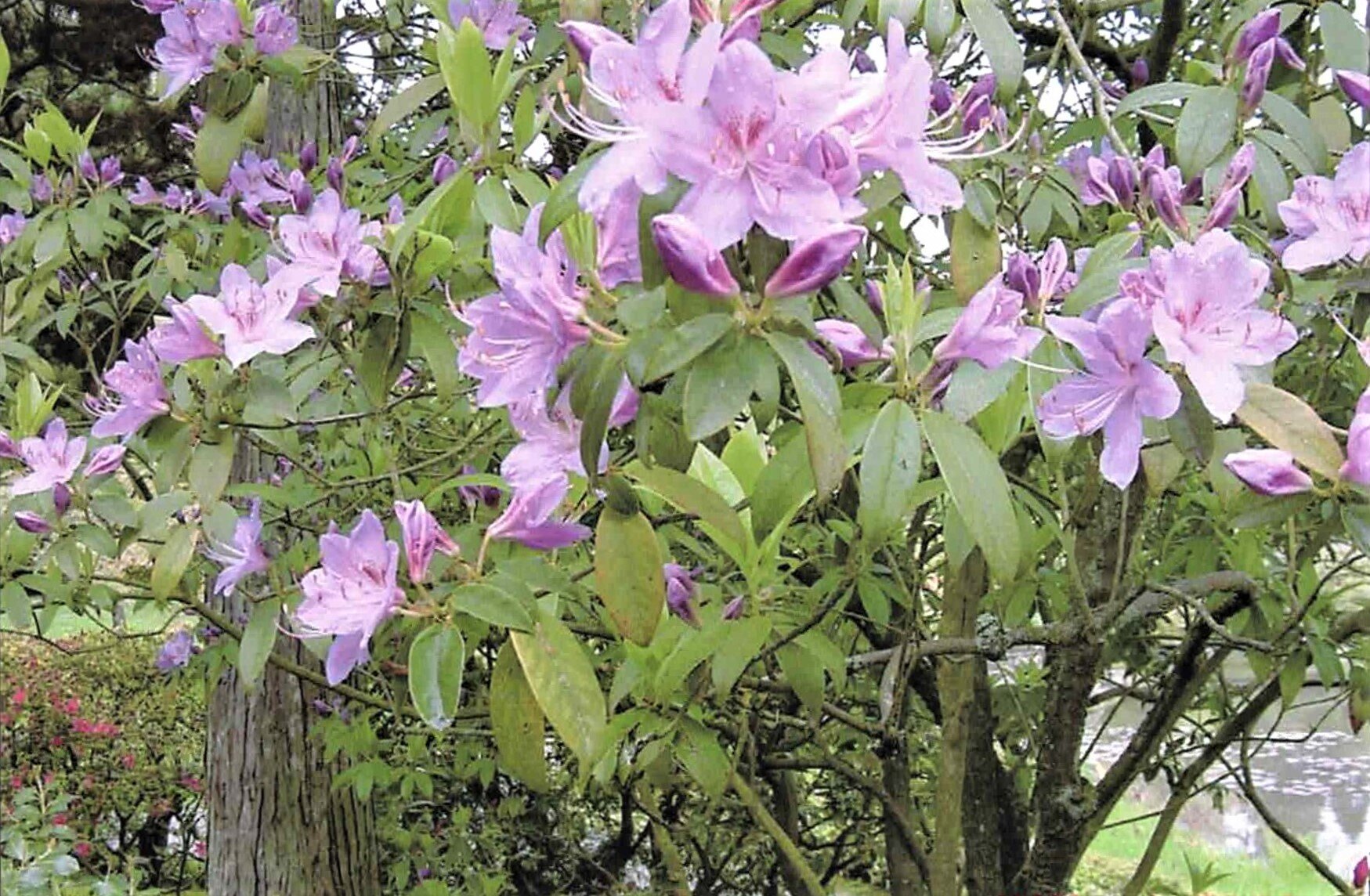The Seattle Japanese Garden, Then & Now | Part One: Rhododendrons and Azaleas
By Corinne Kennedy
View from the Seattle Japanese Garden’s North Hill, with blooming Arnold azaleas in the foreground. (photo: David Rosen)
This is the first in a series of three articles about the Seattle Japanese Garden’s plant collections, and how they’ve changed over time. Here I discuss the genus Rhododendron, which includes both “true” rhododendrons and azaleas. Future articles will feature the Garden’s conifers (Part Two) and maples (Part Three).[1]
Origins of the Washington Park Arboretum (WPA):
We acknowledge that the Seattle Japanese Garden was built on the traditional land of the Duwamish People. Their way of life—hunting, fishing, gathering, and living in harmony with nature—was shattered by the arrival of white settlers of European origin, who stripped the land of its valuable timber (Western red cedar, Douglas fir, and Western hemlock).
Our story begins after 1896, the year logging of this area was completed. In the first years of the 20th century, the City of Seattle made a series of land purchases to establish Washington Park, one of its first parks. Eventually, it would become the site of the City’s arboretum.
[1] Articles in this series were written by Arboretum Unit 86 volunteers—members of the Seattle Japanese Garden’s Plant Committee. In our research, we’ve relied on many SJG and Washington Park Arboretum records, including two books that document the WPA’s plant collections—Woody Plants in the University of Washington Arboretum, Washington Park (Brian O. Mulligan, 1977) and a later version, The Woody Plant Collection in the Washington Park Arboretum (1994). Dan Hinkley’s thesis, An Interpretation of the Maple Collection of the Washington Park Arboretum (1985) and Kathleen Smith’s annual inventory booklets, Plants of the Japanese Garden, have also provided invaluable information.
1936 Olmsted plan for Washington Park Arboretum (HistoryLink / Seattle Municipal Archives)
An arboretum had been established in 1899 on the University of Washington campus, but a permanent site was needed. Ongoing negotiations between the UW and the City of Seattle resulted in the 1924 Suzzallo agreement, which set aside Washington Park for that purpose. Finally, in 1934, the UW Board of Regents and the Seattle Board of Park Commissioners formalized the establishment of the Washington Park Arboretum. The land would be owned by the City of Seattle, and maintained by its Parks Department, but the plant collections would be managed by the University.
The Seattle Japanese Garden and the Arboretum’s Nursery:
Construction of the Japanese tea garden in the Arboretum (Photo: University of Washington, 1959)
In 1960, the Seattle Japanese Garden (3.5 acres) was created within the 230-acre Washington Park Arboretum. Many of its original plants were grown in the WPA’s nursery—an extensive operation that propagated and grew on plant materials obtained from many sources. Later, and sometimes after many years, they were planted in the Arboretum proper or in the Seattle Japanese Garden.
Many plant materials were received from other countries, most often as seeds. Japan, China, England, Scotland, and France were among the most important. A wider range of materials—seeds, cuttings, and young plants—came from within the United States. Major sources were the breeding programs of arboretums and botanic gardens, and individual hybridizers in various states. Plant materials were also obtained from sources in Washington State and the greater Seattle area—nurseries, hybridizers, and Arboretum supporters, including the Seattle Garden Club. When plant materials were received, they were given WPA Accession numbers—numbers that indicate the year received. WPA plant records include Accession numbers, the source of plant materials, plant location, and sometimes actual planting dates. [2]
The Seattle Japanese Garden’s Rhododendrons and Azaleas, 1960-2015:
We turn now to the Garden’s plants in the genus Rhododendron—both “true” rhododendrons and azaleas. (Originally in a genus of their own, azaleas were reclassified in the 19th century. Now they’re included in the genus Rhododendron, and “azalea” is only a common name.) Important design elements within our Garden, rhododendrons and azaleas constitute its largest collection of plants (currently, more than 550) in a single genus. Most have Accession numbers from the late 1930s to the late 1950s, and were likely planted when the Garden was created, or in its first few years.
An important donation of azaleas came from the U.S. Arboretum Plant Introduction Station. In the 1930s, their breeding program developed a series of 454 evergreen azaleas, known as the Glenn Dale Hybrids, and in the years following released them to the WPA and other botanical gardens. Dozens of plants from this program were planted in our Garden.
According to WPA records, some rhododendrons and azaleas were planted in the Garden in the late 1960s or early 1970s. In addition, a relatively small number have been identified as “likely post-1981.” These include plants received as donations and memorials, and those that were planted in the new entry courtyard created as part of the 2009 Gatehouse Project.
We turn now to important examples of the three Rhododendron plant types.
[2] Plants propagated from a particular Accession many years after it was received were given the same number, with its much earlier date.
Evergreen Azaleas—The Most Important Rhododendron Type in the Seattle Japanese Garden
The showy evergreen azalea, Rhododendron ‘Obtusum Arnoldianum’, above the rock wall at the pond’s northern end. (photo: Kathleen Smith, 1989)
Broadleaf evergreens—and particularly evergreen azaleas—are arguably the most important plant type in Japanese-style gardens. Our Garden’s most prominent cultivar is Rhododendron ‘Obtusum Arnoldianum’, planted in a long row above the rock wall at the garden’s northern end, and sheared annually into a low, dense form. Listed on garden designer Jūki Iida’s original planting list and in the 1970 informational booklet, The Japanese Garden, it was planted when the garden was created.
Known as the Arnold azalea, this cultivar with bright fuchsia-pink flowers originated in 1910 at Harvard University’s Arnold Arboretum. It was discovered in a group of chance seedlings—crosses between two Japanese species, Rhododendron obtusum amoenum and R. obtusum kaempferi. Plant materials were originally donated to the WPA in 1938, and our Garden’s azaleas were most likely propagated in the WPA’s greenhouses in the late 1950s. However, they weren’t donated by the Arnold Arboretum—but instead were included in an important collection of rhododendrons and azaleas received from the estate of Charles O. Dexter, a well-known supporter of the Arnold Arboretum and amateur grower of rhododendrons and azaleas.
Deciduous Azaleas
Flowers of the royal azalea, Rhododendron schlippenbachii. (photo: Kathleen Smith, 2006)
Deciduous azaleas are also important shrubs in Japanese-style gardens. Iida’s planting list includes five species, all planted in the garden’s early years. Rhododendron schlippenbachii, known as the royal azalea, is one of the two species native to Eastern Asia. It has pale pink, lightly fragrant, saucer-shaped flowers, and fiery autumn color.
The royal azalea appears in the Garden’s 1970 booklet as well as on Iida’s list, and many were planted in the garden’s first decade. Ten plants remain, most located near the path on the east side of the pond—in the garden’s more informal and partially shaded areas. Unlike evergreen azaleas, they haven’t been subject to frequent shearing. Their delicate flowers and more natural shapes are appropriate for the more naturalistic middle and southern areas of the Garden.
“True” Rhododendrons
Rhododendron augustinii in bloom. (photo: Kathleen Smith, 2003)
The plants we recognize as “true” rhododendrons, rather than azaleas, were not traditionally planted in the gardens of Japan. Mr. Iida wasn’t able to source the broadleaf evergreens so important in Japanese gardens, but he recognized that rhododendrons were popular in the Seattle area and decided that they could serve as substitutes. Those chosen included large species and cultivars with showy flowers in large trusses—and also slow-growing shrubs with small leaves and flowers that visitors might mistake for azaleas.
Rhododendron augustinii is a large-growing species rhododendron with lovely lavender-pink flowers spotted in red. WPA records indicate that seed was received in the 1950s from England and Scotland, and plants were propagated in the WPA nursery. In 1963, several young plants were planted outside the SJG—and then moved, probably within a few years, to two areas inside the Garden. A large specimen—possibly a lesser-known hybrid of R. augustinii known as R. x trichophorum—remains. Located north of the teahouse, east of its waiting arbor (machiai), it adds a note of elegant beauty to the teahouse garden and the mountain area beyond.
The Garden’s Rhododendrons and Azaleas, 2016-the present:
Senior Gardener since late 2015, Peter Putnicki reminds us that he is “constantly engaged in refining, adjusting and thinking about the dynamic, active and living aspect” of the Garden.” Changes to the Rhododendron collection include removing and replacing unhealthy or dying plants, transplanting others to locations better suited to their needs, and adding new plantings as part of major construction projects—e.g., the two evergreen azalea cultivars included in this past winter’s pond edge renovation project. Design elements are also a consideration—a few years ago, for example, several deciduous azaleas were moved because their flower colors clashed with the colors of nearby plants. Most of these changes involve azaleas, rather than the Garden’s “true” rhododendrons. A wide range of other broadleaf evergreens have become available, so existing plants are not often moved and “true” rhododendrons aren’t usually purchased as replacements.
Spring colors near the stone bridge (photo: Aurora Santiago)
Future challenges include the aging of the Garden’s evergreen azaleas. Unfortunately, annual shearing shortens plants’ lives, and the rock wall azaleas, among others, are in decline. (Unfortunately, the Arnold azalea hasn’t gone into commercial production, so another evergreen azalea cultivar will have to be chosen.)
Ultimately, the Garden’s rhododendrons and azaleas are much more than a botanical collection. Their flowering season begins in winter and extends until summer, with one or more plants in bloom throughout that period—a gift of beauty, color, and joy to all who visit.
Corinne Kennedy is a Garden Guide, frequent contributor to the Seattle Japanese Garden blog, and retired garden designer.







